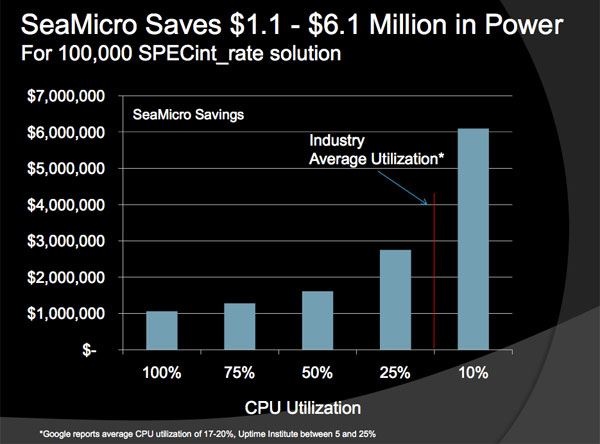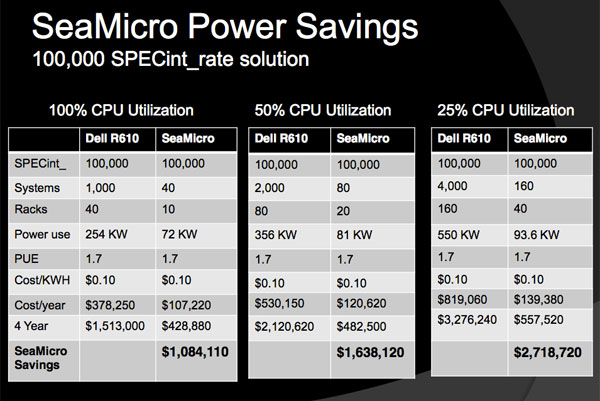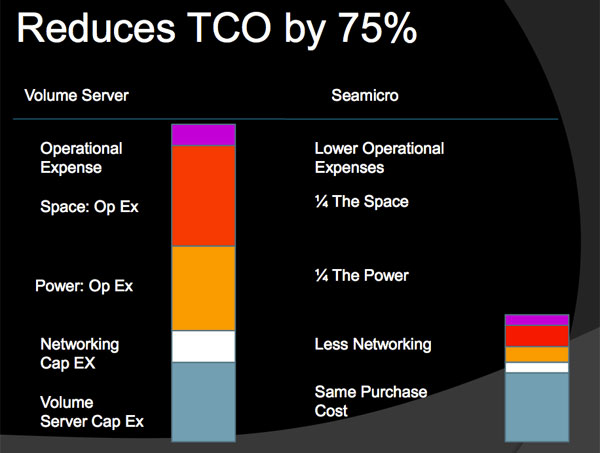SeaMicro Announces SM10000 Server with 512 Atom CPUs and Low Power Consumption
by Anand Lal Shimpi on June 14, 2010 1:38 PM EST- Posted in
- IT Computing
- CPUs
- SeaMicro
Final Words
The base configuration of the SeaMicro SM10000 comes with 512 Atom servers, 1TB of DDR2 memory and no storage. SeaMicro charges $139,000 per SM10000 in this configuration.
It is easy to see how this technology might scale. Simple drop the number of cards used in the server and now you have a lower end configuration. SeaMicro needs to be able to make enough revenue to support its business model so I wouldn’t expect any ultra cheap Atom servers out of the company anytime soon. Scaling down appears to be a top priority, although scaling up is also a possibility.
The limitations are of course numerous. There’s no official Windows support, so this for Linux only deployment. Each server is limited in performance not only by the CPU but also by the memory capacity (2GB). There’s no ECC, no real RAID support (other than striping). It’s very clear that the SM10000 can potentially serve one specific niche very well: a setup with tons of servers that have low CPU usage requirements.
The benefits are clear. If you’re running tons of servers that are mostly idle, the SM10000 could save you boatloads on power. By stripping out most of the components on the motherboard and simplifying each server down to something that consumes roughly 4W of power, SeaMicro does have a very valid solution to the power problem in data centers.

The power savings scale up tremendously. On a large scale the cost of running servers really boils down to hardware, then software then power in order of increasing cost. If you’re running tens of thousands of servers, power consumption becomes a real problem. And this is where SeaMicro is most effective:

I suspect that anyone faced with rising data center power costs will be at least interested in what SeaMicro has to offer.
The obvious argument against the SeaMicro approach is virtualization. Combine multiple servers into one beefy Xeon or Opteron machine and then you start to use those processors at their peak efficiency by keeping them loaded most of the time.

It’s difficult to tell based on a press presentation how well the SeaMicro solution fares against a beefy Xeon server running hundreds of VMs. I don’t doubt that it is a lower power solution, the question is whether or not the performance characteristics work with your specific needs.
From where I stand, the SM10000 looks like the type of product that if you could benefit from having it, you’ve been waiting for something like it. In other words, you will have been asking for something like the SM10000 for quite a while already. SeaMicro is simply granting your wish.










53 Comments
View All Comments
CharonPDX - Monday, June 14, 2010 - link
Except the ENTIRE POINT of this is maximum compatibility with minimum power draw. It is *NOT* meant for maximum power, at all.Intel chips are standard. (They could have used an AMD Geode, or Via Nano, same effect.) They run all standard server OSes, all standard software. If you have to get custom-written server software, there goes your money savings!
Yes, someone could re-compile their software for ARM, but this isn't meant for audiences that recompile their software. It's meant for audiences that need a lot of low-end servers.
code65536 - Tuesday, June 15, 2010 - link
Um, why are you citing flops? Unless this server is being used for scientific computing (or other applications along that sort of line) (for which this is unsuitable anyway for a variety of other reasons), you don't care about how many floating-point operations this thing can do; the number of flops is totally irrelevant. You only care about the integer rate.Shining Arcanine - Tuesday, June 15, 2010 - link
I was probably wrong to call it flops, as what I did was multiply the number of instructions per clock (2) by the clock and the number of of cores.Calin - Tuesday, June 15, 2010 - link
This is consumer-driven equipment and consumer-driven requirements.Many customers would like quite a bit of RAM in their servers, but the processing need would be small enough. Also, they would like to use "industry-standard" software (SQL, Apache, PHP, ...) for Linux, and it might not be completely and totally supported under ARM.
Yes, using ARM processors would give you better everything (I'm not sure about allowing access to 2GB of RAM), but it would be like trying to sell a Formula 1 car to someone living in a swamp.
Shining Arcanine - Tuesday, June 15, 2010 - link
ARM is completely supported by Linux:http://www.gentoo.org/doc/en/handbook/handbook-arm...
http://www.debian.org/ports/arm/
I am running Linux on my Linksys NSLU2 and I can run just about whatever application I want on it.
MySchizoBuddy - Tuesday, July 6, 2010 - link
ARM server using the 4-core Cortex A9 the would have 8 teraflops of computing power.Whats the source of this number. or how did you calculate it.
yanfei - Sunday, July 25, 2010 - link
======= http://www.fashionshoppong.us=======chromal - Monday, June 14, 2010 - link
Or you could instead embrace virtualization and oversubscribe the hardware a little. I'm not sure who is in the market for a $100000+ machine that does even offer basic enterprise features like ECC memory. Seems like a solution in search of a problem. I'm sure the problem is real and 'out there,' but I'm also sure that that the specific instances that wouldn't better be accommodated by other technology are niche, indeed...Myself, I'd rather have one good Xeon X5550 CPU than 24 crappy Atoms.
vol7ron - Monday, June 14, 2010 - link
I'm curious to see how this will pan out.What would the ideal server type be? A web server w/ little computational processes?
I'm trying to think how little the computational processes would be. Would something like a blog/forum based enterprise or maybe a eStore be the ideal? I'm guessing something like a gameserver would not be suitable for this type of technology, nor would something like eBay that's continuously calculating the difference in time?
I'm also curious how this would scale down in price. How much would something like ~20 cores (w/ less memory) run? Something like this seems nice because it seems more economical to add on to.
As stated, it'd be nice to see this in other varieties (ARM-based) with ECC support. For some reason I get the feeling SeaMicro has been at this a while and the Cortex A9 may not have been available when this project was started. Though, I think the A9 also lacks certain instructions that the Intel does provide.
spazoid - Monday, June 14, 2010 - link
This is some very interesting hardware, but I see a problem with the money savings comparison.If you have a Dell R610 running at 100%, you can't replace it with X amount of Atom CPU's until you hit the same SPECint performance. You'd need a lot of these Atom CPU's to equal one Quad core Xeon, and seeing as they can't work together in any way other than access each others virtual harddrives, the comparison is totally ridiculus.
Yes, for something like web servers or similar where the CPU usage on a quad core CPU is very low, this could work, but I don't see any good reason for not just virtualizing such a server, which gives you many advantages that this setup simply cannot provide.